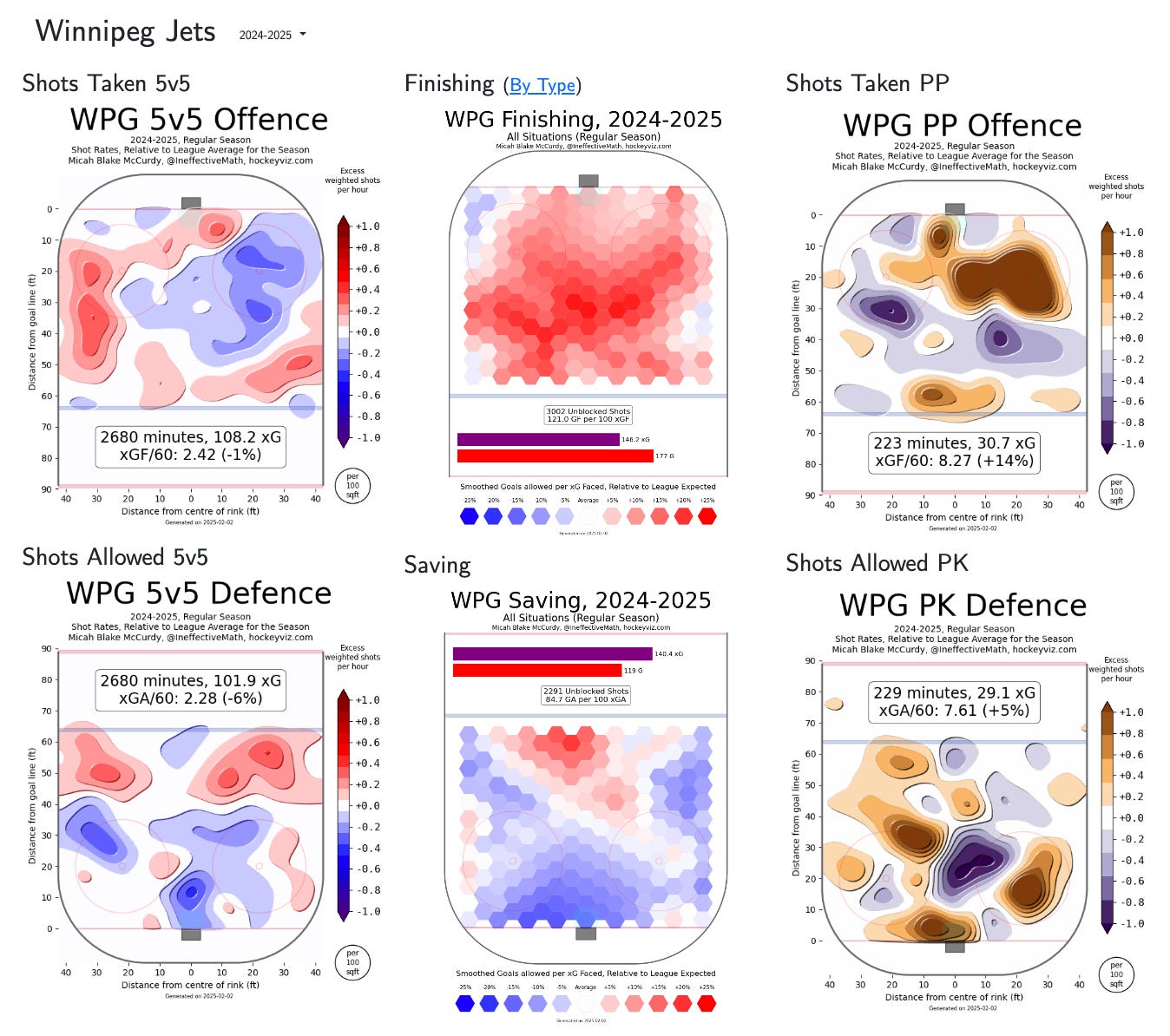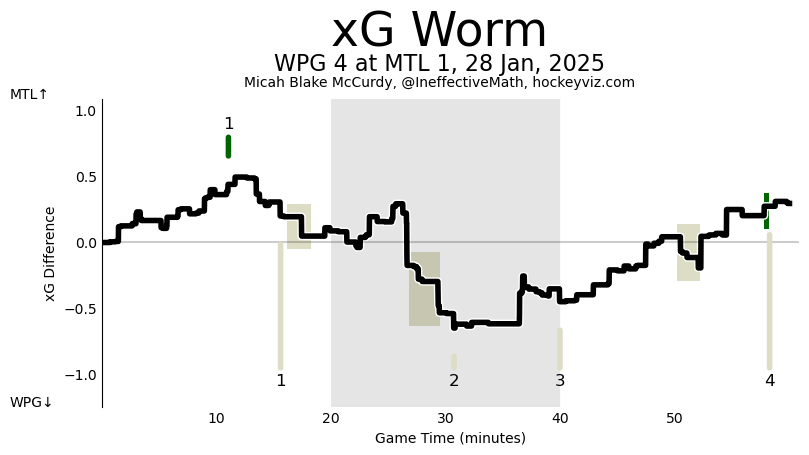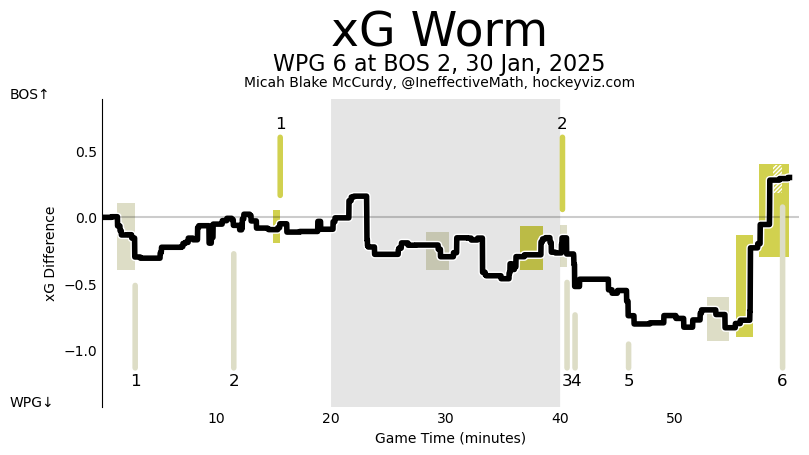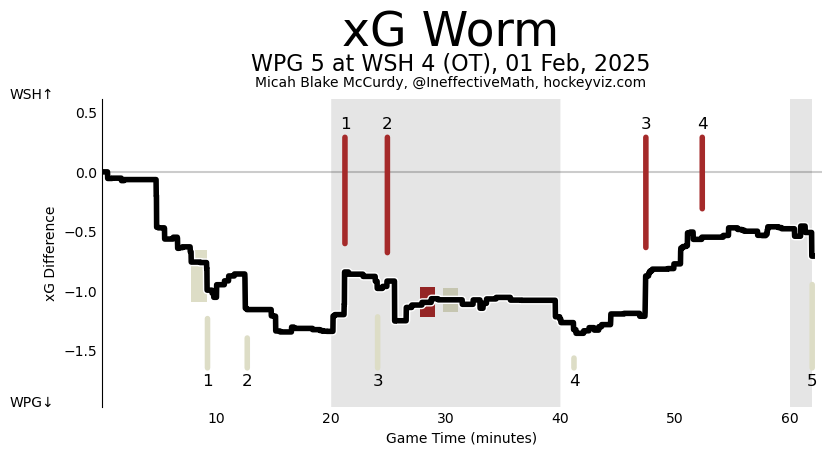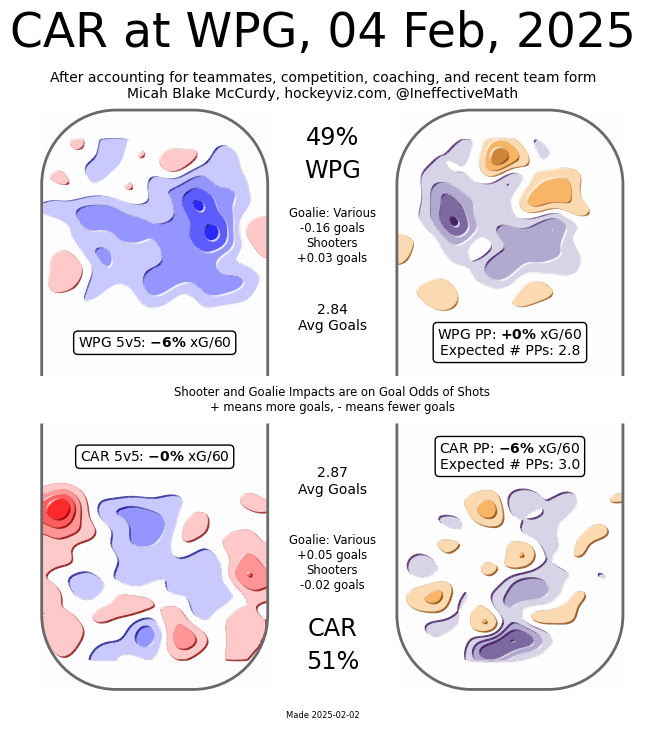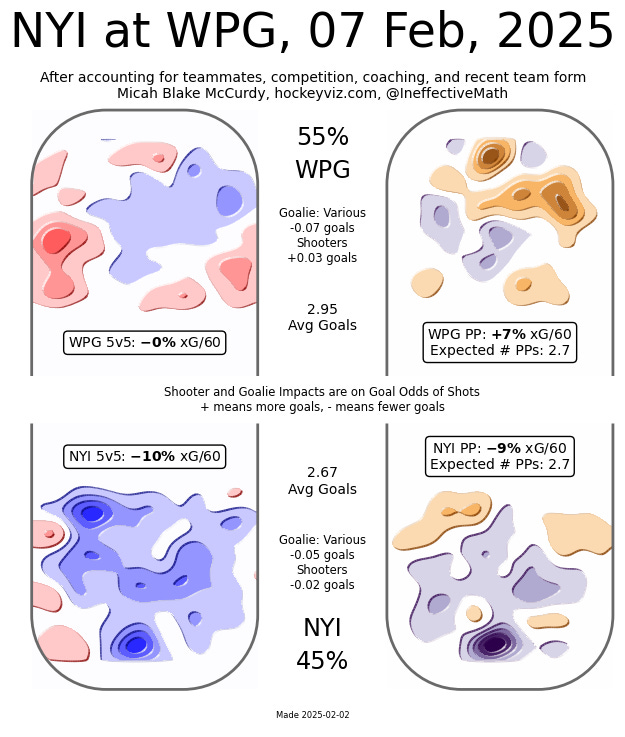Weekly Review: Jets soar with 6 game win streak and looking at AHL fancy stats
Jets weekly review and preview, prospects update, and trending news.
Welcome to The Five Hohl
The best (and only, as far as I know) newsletter entirely dedicated to in-depth, evidence-based analysis of all things Winnipeg Jets. If you're into hockey analytics in general, you'll find some solid insights here too.
Each edition, we’ll review the past week, preview the week ahead, check in on Jets prospects, and dive into trending topics. Premium subscribers also get access to exclusive microstats updates at the end.
QUICK LIFE UPDATE
Getting ready to fly out to Ottawa for two weeks of non-hockey-related work. Fun, fun!
Currently on a break after cutting some weight—dropped about 10 pounds. When I get back from Ottawa, I'll try to maintain what I’ve lost before aiming for another 5–10. After that, it's back to a slow bulk—probably a 1–2 pound per month surplus.
Also waiting to find out if my eldest gets into her catchment school or lands on the waitlist. Apparently, it’s not uncommon to be waitlisted, but also rare for kids not to eventually get placed in their catchment.
JETS WEEKLY REVIEW
The Winnipeg Jets have extended their win streak to six after three more victories this past week. So much for the January crash.
With 77 points, the Jets now lead the league, though they sit second behind the Washington Capitals in point percentage (0.713). They still hold first overall in goal differential (+64), regulation wins (31), and ROW (37).
Here’s a look at where they rank across key goal differential components via Evolving-Hockey.com:
14th in shot differential impact (up 2 spots)
10th in shot quality per shot impact (up 5 spots)
1st in finishing impact (no change)
3rd in goaltending impact (up 1 spot)
Jets continue to improve in shot differential and shot quality performance, which is what the team hopes in order to maximize their chances at the cup.
We wrote yesterday on the subject:
Regularized Adjusted Plus-Minus (RAPM) adjusts for team strength and opponent quality. Here’s where the Jets stand:
Even Strength:
2nd in goal differential (no change)
12th in expected goal differential (no change)
16th in Corsi differential (no change)
Power Play:
1st in goal production (no change)
13th in expected goal production (down 1 spot)
20th in Corsi production (up 2 spots)
Penalty Kill:
18th in goal prevention (down 2 spots)
25th in expected goal prevention (up 3 spots)
26th in Corsi prevention (up 1 spot)
The HockeyViz model incorporates blocked shots, schedule effects, and coaching impacts:
Red/orange-brown means more than league average (good for offense, bad for defense), while blue/purple means less than league average (good for defense, bad for offense).
5v5 Offense (top left): The Jets’ 5v5 offensive chance creation is unchaged from last week, sitting around league average. As noted yesterday, with goaltending, this is the most important area for playoff success.
Power Play (top right): Jets’ power play takes a small half step back in creating chances, but remains strong.
Finishing (top middle): For the first time in months, the Jets’ finishing actually rose. That said, I expect it to mostly regress somewhat throughout the remainder of the season.
5v5 Defense (bottom left): The Jets’ defense here is still strong although slightly less than last week.
Penalty Kill (bottom right): The Jets’ penalty kill… got better two weeks in a row? It’s still bad, but relatively less bad.
Goaltending (bottom middle): This is one of the strongest area for the Jets because Connor Hellebuyck is arguably the best goaltender of his generation.
THE BIG PICTURE
As mentioned yesterday, the Jets are a good team. They’re strong defensively at 5v5 and elite on the power play and in goaltending. However, their weakness at 5v5 offense is less than ideal, as it’s a key factor in playoff success.
That doesn’t mean the Jets are poorly built for the playoffs, but improving that area should be the focus in player acquisitions.
The good news? Their other main weakness—the penalty kill—isn't as critical for playoff performance. That said, they're still below average in that area compared to both the league and true Stanley Cup contenders.
THE GAMES
The Winnipeg Jets outplayed and outmatched the Montreal Canadiens. However, I wasn’t a huge fan of the defensive shell they went into in the third. Solid game overall from the Jets’ top line and top pair.
Like in Montreal, the Jets handled the Boston Bruins convincingly. There were some struggles early on—despite leading on the scoreboard—particularly with Winnipeg handing possession to Boston on nearly every dump-in entry and committing several defensive zone turnovers. Eventually, they cleaned that up and never really looked back.
Boston generated some solid chances late with the goalie pulled, but Winnipeg ultimately sealed the win with an empty net goal.
It was supposed to be a close battle between the league’s two best teams, and while the score was tight, the Jets actually handled the Washington Capitals quite well. It was one of Connor Hellebuyck’s shakier games, showing that even he is human, but the team still pulled off an overtime win.
Aside: I’m curious how the Jets decide which defensive pairs go with which lines. The Stanley pair rarely played with the Namestnikov line in Boston, but they were attached at the hip in Washington.
JETS WEEKLY PREVIEW
Only two games before the break for the Four Nations tournament—or whatever it’s called…
Winnipeg faces the Carolina Hurricanes, who sit second in the East behind Washington.
Carolina is about league average in finishing and goaltending but elite everywhere else. General Manager (and friend of the blog) Eric Tulsky has built a team that generates a ton of shots—both low and high quality—while also preventing plenty against.
I'm curious why Tulsky believes an above-average power play and a below-average penalty kill combine to limit Carolina’s chances.
The Hurricanes have standout offense on their top line with Aho and Rantanen, but they also boast a Lowry-esque shutdown second line with Staal, Martinook, and Jarvis.
Meanwhile, the New York Islanders… aren’t that good. They haven’t been for a while, though goaltending masked their issues for a few years.
That said, they still have high-end talent. Barzal (currently day-to-day) is elite, and Lee remains highly capable. Their back end features a few strong skaters, though not all get the ice time or usage they deserve. Dobson (IR) is excellent. Perunovich and Pelech form a very solid second pairing that delivers first-pairing results. Reilly (IR) was underutilized when healthy.
But… a Romanov-DeAngelo top pairing? That leaves a lot to be desired, as both are better suited for third-pairing roles.
PROSPECT RECAP
I’m starting to think the Moose—currently second last in the league in points percentage—might not be a very good team.
They rank 21st in shots on net share (shots for as a percentage of all shots). They’re 24th in shots for per game and 19th in shots against per game. That’s not terrible, but they sit dead last in shooting percentage and PDO, and second worst in both power play efficiency and save percentage.
To try and turn things around, the Moose sent down Milic and called up DiVincentiis. Before Kahkonen was reassigned, DiVincentiis actually posted a respectable save percentage. However, since his AHL call-up, he hasn’t posted a single game above 900.
I’ve added a couple more stats to the tables: AHL game score and 5v5 relative goal percentage. Neither is perfect for evaluating players, but they provide an extra layer of context.
Elias Salomonsson is back, giving the team some much-needed support. That said, I’m not sure why the Moose are pairing him with an off-hand Dylan Coghlan.
While Salomonsson’s return helps, the Moose have lost their three best forwards. Brad Lambert and Nikita Chibrikov were high-impact players, and Parker Ford had been the team’s highest-scoring forward at even strength.
Mason Shaw and Dominic Toninato each scored a goal in three games.
Chaz Lucius played two of the three games. He hasn’t produced on the power play but has kept pace with Chibrikov and Lambert at even strength.
AJF isn’t scoring, but he’s been one of the better forwards at 5v5 in terms of outscoring opponents. He picked up an assist.
Dylan Coghlan scored a goal. He’s been significantly outscored in the AHL, though I’m not sure I’d blame him entirely.
Isaak Phillips recorded another assist, and his defensive partner—who probably wouldn’t be in the AHL if not for his fisticuffs—finally got his first point of the season.
Jaret Anderson-Dolan and Fabian Wagner each picked up an assist.
Some quick notes (reminder, only showing reg season games above):
Dmitry Rashevsky: An assist over three games.
Kristian Vesalainen: No games.
Kieron Walton: A goal and an assist over two games.
Brayden Yager: Three goals over two games.
Kevin He: No games.
Colby Barlow: After a flurry of scoring, his point streak comes to an end with no points in the last two games.
Connor Levis: A goal and assist over three games. I’ve made this joke before, but a statline that I can almost keep for every week.
Zachary Nehring: Played two games.
Alfons Freij: Did not play.
Markus Loponen: Three games and three assists.
Jacob Julien: A goal and assist over two games.
Garrett Brown: He got a point! Brown scored his first point of the season, now at 24 games played.
When the Moose were good
I’m skipping current news in this post because I’ll be continuing our trade deadline preview series next. Instead, I want to take a quick look at how the Manitoba Moose defenders performed when the team was actually stacked.
It’s interesting how the four best skaters in relative goal share are the four who made the NHL. No idea if that’s actually meaningful or just a coincidence. And if it is meaningful, is it because of actual performance or just perceived performance?
When I worked with AHL data for NHL teams half a decade ago, I had much better models than just goals or relative goal percentage—so I never really looked into it. Haha.
TFH TRADE BAIT BOARD
Generally speaking, I take a very systematic approach when selecting which players to analyze for these boards. I start by compiling a list of pending UFAs from teams with less than a 10% chance of making the playoffs. Then, I cross-check trade bait boards to add any additional names of interest.
That said, if there’s a player you’d like me to analyze, let me know! You can reach out via email, comments, or send a message/post on BlueSky, Facebook, Reddit, or Twitter.
MICROSTATISTICS GAME REVIEW
Keep reading with a 7-day free trial
Subscribe to The Five Hohl to keep reading this post and get 7 days of free access to the full post archives.




